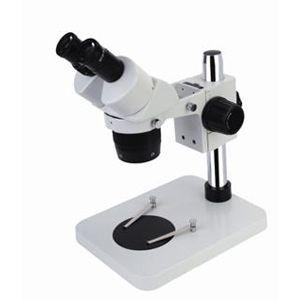What Are the Applications of Stereo Microscopes?

Stereo microscopes are incredibly versatile tools, finding applications in a wide range of fields due to their unique ability to provide a 3D view of specimens with a comfortable working distance. Here's a detailed look at some key applications:
l Industrial Inspection and Quality Control: In manufacturing, stereo microscopes are indispensable for inspecting small parts, circuit boards, welds, and other components. They help identify defects, ensuring quality control and product reliability in industries like electronics, jewelry making, watch repair, and more.
l Manufacturing and Assembly: The 3D view and ample working distance make stereo microscopes ideal for assembling small and intricate devices. This is crucial in industries like electronics, medical device manufacturing, and watchmaking, where precision is paramount.
l Biological Research and Dissection: Researchers use stereo microscopes for dissecting specimens, examining tissues, and observing small organisms. They are valuable tools in fields like zoology, botany, and medicine, allowing for detailed study of biological structures.
l Medical and Surgical Applications: In some surgical procedures, particularly microsurgery, stereo microscopes provide surgeons with magnified 3D views for delicate manipulations. They are also used in dental work and other medical fields where precision is essential.
l Education and Training: Stereo microscopes are widely used in educational settings to teach students about microscopy, biology, and other scientific disciplines. They allow students to examine real-world objects in detail, fostering a deeper understanding of the subject matter.
l Hobbyist Use: Many hobbyists use stereo microscopes for examining stamps, coins, minerals, insects, plants, and other small objects. They are a popular tool for nature enthusiasts, collectors, and model builders, allowing them to explore the intricate details of their interests.
l Forensic Science: Forensic scientists use stereo microscopes to examine evidence such as fibers, hair, and other trace materials. The 3D view helps in identifying and comparing minute details, contributing to investigations and legal proceedings.
l Art Restoration and Conservation: Conservators use stereo microscopes to examine the fine details of artwork, identifying damage and guiding restoration efforts. They are crucial for preserving cultural heritage and ensuring the longevity of valuable artifacts.
l Gemology: Gemologists use stereo microscopes to examine gemstones, identifying inclusions, evaluating clarity, and assessing their quality. They are essential tools for appraising and classifying gemstones.
l Entomology: Entomologists use stereo microscopes to study insects, identifying species and examining their anatomy. They are valuable for research in biodiversity, ecology, and pest control.

- Art
- Causes
- Crafts
- Dance
- Drinks
- Film
- Fitness
- Food
- Spellen
- Gardening
- Health
- Home
- Literature
- Music
- Networking
- Other
- Party
- Religion
- Shopping
- Sports
- Theater
- Wellness


